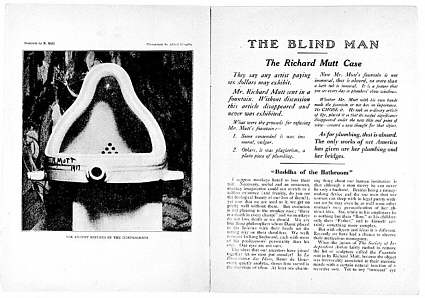AVANT GARDE
The oxford Enlgish dictionary defines avant garde as -
• new and experimental ideas and methods in art, music, or literature:he has been called a promoter of the avant-garde
• a group of artists, musicians, or writers working with new and experimental ideas and methods:works by artists of the Russian avant-garde
adjective
• favouring or introducing new and experimental ideas and methods:a controversial avant-garde composer
In short, Avant Garde is thinking outside the box, experimenting. In French it means "vanguard" or "advance guard". It is at the opposite end of the spectrum from the term "status quo" which means something that follows tradition and form.
To be avante garde you basically push the limits of what is considered traditional, usually in the fields of politics, art, or music. Its aim is to be individual and revolutionary. It's challenging peoples conventions of "art" so much so that it is often questioned and looked down on.
Marcel Duchamp's fountain 1917.
This is a perfect example of Avant Garde art. A urinal is signed and submitted for the Society of Independent Artists 1917 exhibition. It was submitted under the alias - R.Mutt, presumably to hide his involvement with the piece but it is more likely that Duchamp was attacking the idea of the artist and the authenticity of the artist and the price of the artist's signature. the Society of Independent Artists said that they would exhibit every piece that was submitted but when they saw "R.MUTT'S" submission, questions were raised and was eventually hidden from view. The board members questioned whether the piece would be considered as art.
Durchamp's fountain attacks the art establishment. It challenges the conventional idea of what art is and that what Durchamp was doing , He was testing what people thought of as art.
The Blind Man an art and Dada journal published by the New York Dadaists in 1917.
A reaction was written by the group in the defense of Duchamp's submission being rejected.
"Whether Mr Mutt made the fountain with his own hands or not has no importance. He CHOSE it. He took an article of life, placed it so that its useful significance disappeared under the new title and point of view – created a new thought for that object."
This was really the "rationale" or the idea behind the fountain. In whole, It represents the up yours gesture to the art establishment.
Fauves Wild Beasts by Henri Mattise is of the Fauves style ( which Matisse was one of the founders and leaders) Fauvism was a short lived movement notorious for it's use of strong colour and brush strokes over the representational or realistic values retained by Impressionism.
Art critiques were disgusted by this as it involved new techniques and showed almost no respect for the traditional methods. But what Matisse was doing was redefining the technique in art. While he used unrealistic methods, his subject matter was very real. Classical art also painted in modernism, depicted fantasy scenes, stuff of fiction but was seen more "realistic" and was a a lot safer because they used traditional methods
The Stone Breakers by french artist Gustave Courbet. It's message is a political one and shows social change. It's avant garde because it depicts two working class males breaking rocks instead of the usual scenes of royalty or religion.
stefan sagmeister's AIGA New Orleans (1997) was designed to be avant garde. It almost doesnt care about communication and there doesnt appear to be any visual rules or guidelines. It loses it's understandability.
Art for art's sake
Art for art's sake' is art that has no political meaning behind it. It's just there for aesthetics. This approach dominated much thinking and practice in 20th Century art.It was experimental but ran the risk of no one understanding your work
No. 5, 1948 Jackson Pollock.
Pollock's "drip paintings" marked the dawn of a movement of modern art known as abstract expressionism. These drip paintings were produced by a method by which pollock would pour and splash and drip paint onto canvases. He referred to this method as "Action painting" a style of painting where paint is spontaneously dribbled or splashed or smeared all over the canvas rather than being carefully applied by a brush. So the result emphasises the physical act of painting as being an essential aspect of this finished work or concern of the artist. It emphasises the act of painting just as much as the painting it self. Pollock insisted that his drip pains werent about anything they were just art in its purest most autonomous form
No. 5, 1948 Jackson Pollock.
Pollock's "drip paintings" marked the dawn of a movement of modern art known as abstract expressionism. These drip paintings were produced by a method by which pollock would pour and splash and drip paint onto canvases. He referred to this method as "Action painting" a style of painting where paint is spontaneously dribbled or splashed or smeared all over the canvas rather than being carefully applied by a brush. So the result emphasises the physical act of painting as being an essential aspect of this finished work or concern of the artist. It emphasises the act of painting just as much as the painting it self. Pollock insisted that his drip pains werent about anything they were just art in its purest most autonomous form






No comments:
Post a Comment